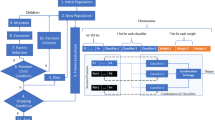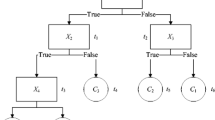Abstract
Artificial Immune Recognition System (AIRS) classifier algorithm is robust and effective in medical dataset classification applications such as breast cancer, heart disease, diabetes diagnosis etc. In our previous work, we have proposed a new resource allocation mechanism called fuzzy resource allocation in AIRS algorithm both to improve the classification accuracy and to decrease the computation time in classification process. Here, AIRS and Fuzzy-AIRS classifier algorithms and one against all approach have been combined to increase the classification accuracy of obstructive sleep apnea syndrome (OSAS) that is an important disease that influences both the right and the left cardiac ventricle. The OSAS dataset consists of four classes including of normal (25 subjects), mild OSAS (AHI (Apnea and Hypoapnea Index) =5-15 and 14 subjects), moderate OSAS (AHI < 15-30 and 18 subjects), and serious OSAS (AHI > 30 and 26 subjects). In the extracting of features that is characterized the OSAS disease, the clinical features obtained from Polysomnography used diagnostic tool for obstructive sleep apnea in patients clinically suspected of suffering from this disease have been used. The used clinical features are Arousals Index (ARI), Apnea and Hypoapnea Index (AHI), SaO2 minimum value in stage of REM, and Percent Sleep Time (PST) in stage of SaO2 intervals bigger than 89%. Even though AIRS and Fuzzy-AIRS classifiers have been used in the classifying multi-class problems, theirs classification performances are low in the case of multi-class classification problems. Therefore, we have used two classes in AIRS and Fuzzy-AIRS classifiers by means of one against all approach instead of four classes comprising the healthy subjects, mild OSAS, moderate OSAS, and serious OSAS. We have applied the AIRS, Fuzzy-AIRS, AIRS with one against all approach (Pairwise AIRS), and Fuzzy-AIRS with one against all approach (Pairwise Fuzzy-AIRS) to OSAS dataset. The obtained classification accuracies are 63.41%, 63.41%, 87.19%, and 84.14% using the above methods for 200 resources, respectively. These results show that the best method for diagnosis of OSAS is the combination of AIRS and one against all approach (Pairwise AIRS).




Similar content being viewed by others
References
AASM., Sleep-related breathing disorders in adults: recommendations for syndrome definition and measurement techniques in clinical research. The Report of an American Academy of Sleep Medicine Task Force, SLEEP, Vol. 22, No. 5, 1999.
Eliot, S. K., Lutz, J., Black, C., and Marcus, C. L., Pulse Transit Time as a measure of arousal and respiratory effort in children with sleep-disorder breathing. Pediatr. Res. 53:4580–588, 2003April 1.
Al-Ani, T., Hamam, Y., Novak, D., Pozzo Mendoza, P. T., Lhotska, L., Lofaso, F. , et al., Noninvasive automatic sleep apnea classification system. BioMedSim’05, Linköping, Sweden, 2005May 26–27.
Al-Angari, H. M., and Sahakian, A. V., Use of sample entropy approach to study heart rate variability in obstructive sleep apnea syndrome. IEEE Trans. Biomed. Eng. 54:1900–1904, 2007.
del Campo, F., Hornero, R., Zamarron, C., Abasolo, D. E., and Alvarez, D., Oxygen saturation regularity analysis in the diagnosis of obstructive sleep apnea. Artif. Intell. Med. 37:111–118, 2006.
Kwiatkowska, M., and Schmittendorf, E., Assessment of Obstructive Sleep Apnea using Pulse Oximetry and Clinical Classification Rules: a Fuzzy Logic Approach, BMT, 2005.
http://classes.kumc.edu/cahe/respcared/cybercas/sleepapnea/trenpoly.html (last accessed: 2008).
Rechtschaffen, A., and Kales, A., A manual of standardized terminology, techniques and scoring system for sleep stages of human subjects. US Government-Printing Office, Washington, DC, 1979National Institutes of Health Publication No. 204.
American Thoracic Society consensus statement., Indications and standards for cardiopulmonary sleep statement. Am. Rev. Respir. Dis. 139:559–568, 1989.
American Academy of Sleep Medicine Task Force., Sleep related breathing disorders in adults: recommendations for syndrome definition and measurement techniques in clinical research. Sleep. 22:667–689, 1999.
Douglas, N. J., Thomas, S., and Jan, M. A., Clinical value of polysomnography. Lancet. 339:347–350, 1992.
Xu, L., Chow, M.-Y., Timmis, J., and Taylor, L. S., Power distribution outage cause identification with imbalanced data using artificial immune recognition system (AIRS) algorithm. IEEE Trans. Power Syst. 22:1198–204, 2007.
Hamaker, J., and Boggess, L., “Non-Euclidean Distance Measures in AIRS, an Artificial Immune Classification System” in 2004 Congress on Evolutionary Computation (CEC 2004), pp. 1067–1073, 2004.
Watkins, A., and Timmis, J., “Artificial Immune Recognition System (AIRS): Revisions and Refinements” in 1st International Conference on Artificial Immune Systems (ICARIS 2002), Canterbury, UK, pp. 173–181, 2002.
Watkins, A. B., Exploiting Immunological Metaphors in the Development of Serial, Parallel, and Distributed Learning Algorithms. PhD dissertation, University of Kent, Canterbury, UK, March, 2005.
Watkins, A., and Timmis, J., Artificial Immune Recognition System (AIRS): Revisions and Refinements, Proc. Int. Conf. on Artificial Immune Systems (ICARIS), 99–106, 2002.
Goodman, D. E, Boggess, L., and Watkins A., An investigation into the source of power for AIRS, an artificial immune classification system. In Proceedings of the International Joint Conference on Neural Networks (IJCNN’03), Portland, Oregon July 1678–1683, 2003.
Polat, K., Kara, S., Latifoglu, F., and Günes, S., A novel approach to resource allocation mechanism in artificial immune recognition system: Fuzzy resource allocation mechanism and application to diagnosis of atherosclerosis disease, ICARIS. Lect. Notes Comput. Sci. 4163:244–255, 2006.
Liu, Y., and Zheng, Y. F., One-against-all multi-class SVM classification using reliability measures, Neural Networks, 2005. IJCNN ‘05. Proceedings. 2005 IEEE International Joint Conference, 2, 849–854, 31 July–4 Aug, 2005.
Polat, K., Yosunkaya, Ş., and Güneş, S., Pairwise ANFIS approach to determining the disorder degree of obstructive sleep apnea syndrome. J. Med. Syst., 2008 (in press), accepted in March, 2008.
Acknowledgement
This study is supported by the Scientific Research Projects of Selcuk University.
Author information
Authors and Affiliations
Corresponding author
Rights and permissions
About this article
Cite this article
Polat, K., Yosunkaya, Ş. & Güneş, S. A New Approach to Diagnosing of Importance Degree of Obstructive Sleep Apnea Syndrome: Pairwise AIRS and Fuzzy-AIRS Classifiers. J Med Syst 32, 489–497 (2008). https://doi.org/10.1007/s10916-008-9155-7
Received:
Accepted:
Published:
Issue Date:
DOI: https://doi.org/10.1007/s10916-008-9155-7




